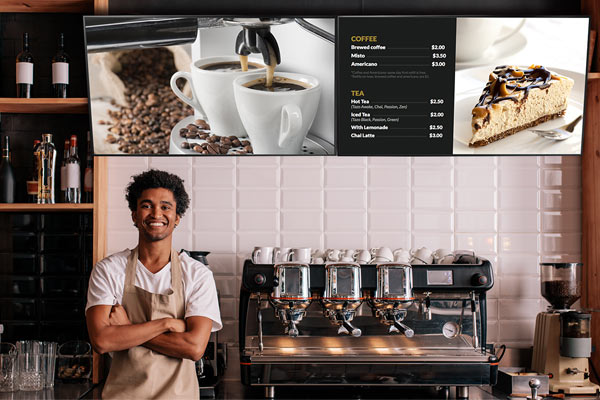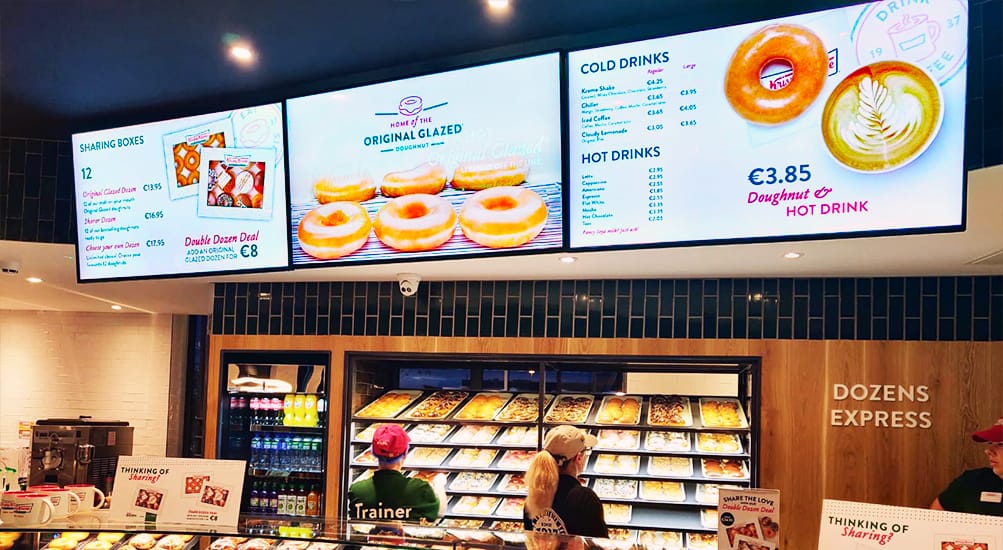
Digital Menu Boards
Digital Menu Boards In today's fast-paced digital age, businesses are constantly looking for innovative ways to enhance customer experiences and streamline operations. One such advancement that has gained significant traction in the restaurant industry is the implementation of digital menu boards. Gone are the days of static, printed menus. These dynamic and interactive displays are transforming the way customers engage with menus, while also providing numerous benefits for restaurant owners. In this article, we will explore the power of digital menu boards and how they are revolutionizing the dining experience.
Enhanced Visual Appeal:
Digital Menu Boards One of the primary advantages of digital menu boards is their ability to captivate customers with stunning visuals. Unlike traditional menus, digital displays allow restaurants to showcase their offerings in vibrant colors, high-definition images, and even videos. This visually appealing presentation not only attracts attention but also enhances the overall dining experience. Customers are more likely to explore various menu items and make informed decisions when they are visually enticed by appetizing food images displayed on these digital screens.
Real-Time Updates and Flexibility:
Keeping menus up to date has always been a challenge for restaurant owners. With traditional printed menus, any changes to prices, ingredients, or specials require costly reprints and time-consuming manual updates. Digital menu boards eliminate these hassles by providing real-time updates and flexibility. Changes can be made instantly across multiple locations, ensuring consistency and accuracy. For example, if a dish runs out of stock, it can be promptly removed from the digital menu board, preventing customer disappointment. This agility allows restaurants to adapt quickly to changes in inventory, seasonal offerings, or promotions, providing customers with the most up-to-date information.
Promotions and Upselling Opportunities:
Digital menu boards provide an excellent platform for showcasing promotions and upselling opportunities. With their dynamic nature, these boards can easily rotate through different offers and highlight daily specials, happy hour deals, or limited-time promotions. By strategically placing eye-catching visuals and persuasive messaging, restaurants can entice customers to try new menu items or upgrade their orders. Moreover, digital menu boards can display complementary food and beverage pairings, influencing customers to make additional purchases. This not only increases revenue but also helps in promoting new or underutilized menu items.
Improved Customer Engagement:
Digital menu boards foster increased customer engagement through interactive features. Some advanced systems allow customers to personalize their orders, customize ingredients, or even provide feedback through touchscreens integrated into the displays. This interactive element empowers customers to have a more personalized dining experience and ensures that their preferences are met. Furthermore, digital menu boards can incorporate social media feeds, customer reviews, or live updates, enabling customers to interact with the brand in real-time and share their experiences with others online.
Analytics and Data-Driven Insights:
Digital menu boards offer a wealth of data and insights that can significantly benefit restaurant owners. By tracking customer interactions and ordering patterns, these systems provide valuable analytics that can inform menu optimization, pricing strategies, and operational decisions. For instance, data on the most popular items or frequently ordered combinations can help streamline inventory management and optimize ingredient procurement. Additionally, customer feedback collected through interactive features can be analyzed to identify areas of improvement and enhance overall customer satisfaction.
Conclusion:
Digital menu boards have emerged as a game-changer in the restaurant industry, revolutionizing the dining experience for customers and streamlining operations for owners. From enhanced visual appeal to real-time updates, promotions, and customer engagement, these dynamic displays offer a myriad of benefits. The ability to captivate customers with visually stunning content, coupled with the flexibility to make instant updates and showcase promotions, make digital menu boards a powerful tool for driving revenue and improving customer satisfaction. As technology continues to evolve, we can expect further innovations in this space, providing even more exciting and immersive dining experiences.
Digital Menu Boards How Its Works?
Digital menu boards operate through a combination of hardware and software components. Let's take a closer look at how they work:
Hardware Components:
- Display Screens: Digital menu boards typically consist of high-resolution display screens, which can range from small screens for individual tables to large screens for wall-mounted or freestanding displays. These screens can be LCD, LED, or OLED panels, depending on the desired image quality and budget.
- Media Players: A media player is a device that connects to the display screens and is responsible for storing and playing digital content. It can be a dedicated device or integrated within the display itself. The media player receives instructions from the software and renders the content onto the screen.
- Mounting and Connectivity: The display screens are mounted securely in the desired locations, either on walls, stands, or as tabletop displays. They are connected to the media player via cables or wirelessly, depending on the setup. Power and network connections are also established to ensure continuous operation and content updates.

Software Components:
- Content Management System (CMS): The CMS is the central software that allows restaurant owners or managers to create, schedule, and manage the content displayed on the digital menu boards. It provides a user-friendly interface where users can upload images, videos, and other media, as well as organize them into playlists or schedules.
- Design Tools: Many CMS platforms include design tools that enable users to create visually appealing menus by adding images, videos, text, and other graphical elements. These tools often offer templates, pre-designed layouts, and customization options, allowing restaurants to maintain their brand identity.
- Scheduling and Playlist Management: The CMS allows users to schedule different content to be displayed at specific times or days. This feature is particularly useful for restaurants with varied menus, such as breakfast, lunch, and dinner. Users can also create playlists to sequence and rotate content, ensuring a dynamic and engaging display.
- Remote Management: With digital menu boards, changes can be made remotely from a centralized location. The CMS enables restaurant owners or managers to update prices, add or remove menu items, and make other modifications across multiple locations simultaneously. This feature ensures consistency and saves time compared to manual updates.
Workflow:
- Content Creation: Using the design tools provided by the CMS, users create visually appealing menus by selecting or creating images, videos, and other graphical elements. They can also add text, pricing information, and special offers.
- Content Upload: The created content is uploaded to the CMS, where it is organized, categorized, and assigned to specific display screens or playlists.
- Content Scheduling: Users schedule the content to be displayed at specific times or days, aligning with the restaurant's operational hours or promotions.
- Content Publishing: The CMS pushes the scheduled content to the media players connected to the display screens. The media players receive the content instructions and render the visuals onto the screens.
- Real-time Updates: When changes are required, such as price updates or menu item additions/removals, users can make the modifications through the CMS, and the changes are promptly reflected on the digital menu boards.
Final Words:
In summary, digital menu boards work by combining hardware components such as display screens and media players with software components like a content management system. The CMS allows users to create, schedule, and manage visually appealing content, which is then displayed on the digital menu boards in real time. This technology provides restaurant owners with the flexibility to update menus, showcase promotions, and engage customers more effectively, enhancing the overall dining experience.


No comments yet